ESP32 Water Leak Detector (with notification)
Using the ESP32’s capacitive touch GPIOs, it’s relatively easy to build a water leak detector using ESPHome. M5StickC was chosen as a platform due to the integrated Grove connector for clean connections and the fact it’s well housed. The built-in display is a bonus, but not strictly necessary. Notifications are performed via HomeAssistant’s ‘alert’ and ’notify’ facilities, which send via Pushover to iOS & Android.
Things you’ll need
M5Stick axp192 custom component This is needed to power up the display. You don’t need the st7735 display driver, as it is already included with ESPHome >1.16.0.
M5StickC ESP32 development kit M5Stack Link
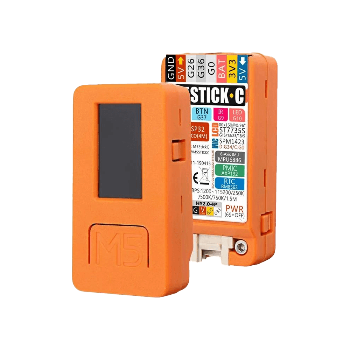
- Moisture sensor This example uses a Guardian Remote Sensor Probe which has a 6’ cord.
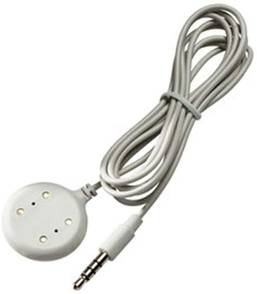
- Grove connector pigtail Amazon Link
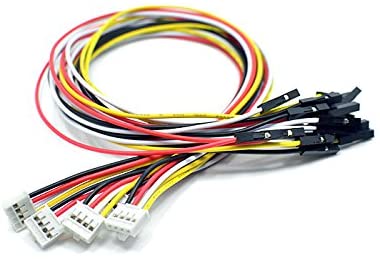
- USB power supply with USB-C cable (the M5StickC comes with the short black USB cable seen in the pictures)
Probe Connection
Since the probe comes with an integrated 3.5mm male plug, a 3.5mm female jack has been connected to the Grove port to allow easy probe replacement in the future. Orange connects to orange, blue connects to blue. The pads on the opposite side of the probe are internally-connected identically to the front. The two middle rings on the 3.5mm jack are unused. There is no polarity – simply connect one terminal (orange or blue) to Grove GND, and the other to Grove G33.

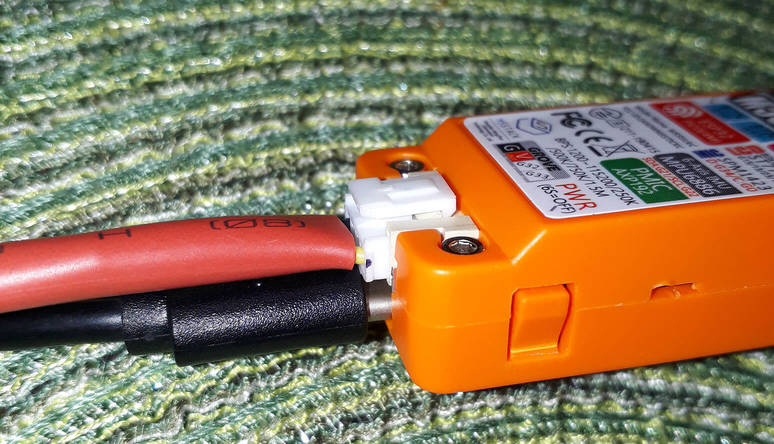
Assembled Components

ℹ️ Note
Even though the M5StickC has a battery inside (which might be enough to cover short power outages), you’ll need to keep the unit on USB power 24/7.
Display Font
You’ll need to place the OpenSans-Regular font (or another of your choosing) alongside your ESPHome yaml file. See - Display Component.
Calibration & Testing
Once everything is hooked up and flashed, enable esp32_touch: setup_mode: true and proceed to adjust the threshold
setting on the touch-sensitive binary sensor (GPIO33) to find the proper value for your particular moisture sensor and
cabling situation. Grab a glass of water for testing, another for yourself, and dip away while watching the logs.
Your goal is to find a threshold value that is sufficient to trigger the binary sensor in water, but not otherwise.
See ESP32 Touch Pad for more information.
Normal state
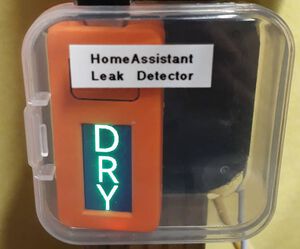
Wet state
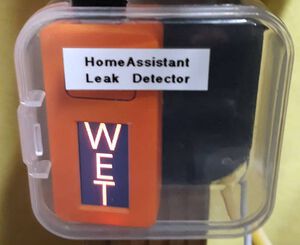
Installed Project
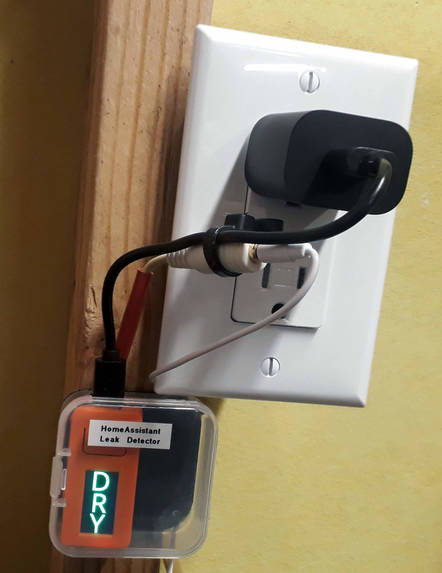
Not shown: Probe is placed on the floor in the corner, out of the way, in the lowest part of the room
ESPHome configuration
substitutions:
devicename: basement_leak_detector
friendly_name: Basement Leak Detector
device_description: Leak detector in basement utility room
esphome:
name: $devicename
comment: ${device_description}
esp32:
board: m5stick-c
wifi:
ssid: !secret wifi_ssid
password: !secret wifi_password
# Enable fallback hotspot (captive portal) in case wifi connection fails
ap:
password: !secret fallback_ap_password
captive_portal:
logger:
# Enable Home Assistant API & OTA Updates
api:
ota:
platform: esphome
status_led:
pin:
number: GPIO10
inverted: true
spi:
clk_pin: GPIO13
mosi_pin: GPIO15
i2c:
- id: bus_a
sda: GPIO21
scl: GPIO22
scan: true
esp32_touch:
#setup_mode: true
iir_filter: 10ms
binary_sensor:
- platform: gpio
pin:
number: GPIO37
inverted: true
id: button_a
on_press:
then:
- switch.toggle: led1
- platform: gpio
pin:
number: GPIO39
inverted: true
id: button_b
on_press:
then:
- switch.toggle: led1
- platform: status
name: "${friendly_name} Status"
- platform: esp32_touch
name: "${friendly_name} Sensor"
device_class: moisture
id: leak
pin: GPIO33
threshold: 30
on_press:
- while:
condition:
binary_sensor.is_on: leak
then:
- switch.turn_on: led1
- delay: 200ms
- switch.turn_off: led1
- delay: 100ms
- switch.turn_on: led1
- delay: 200ms
- switch.turn_off: led1
- delay: 400ms
on_release:
then:
- switch.turn_off: led1
sensor:
- platform: uptime
name: "${friendly_name} Uptime"
# AXP192 power management - must be present to initialize TFT power on
- platform: axp192
address: 0x34
i2c_id: bus_a
update_interval: 30s
battery_level:
name: "${friendly_name} Battery Level"
id: "m5stick_batterylevel"
- platform: wifi_signal
name: "${friendly_name} WiFi Signal"
update_interval: 60s
text_sensor:
- platform: version
name: "${friendly_name} ESPHome version"
switch:
- platform: gpio
pin:
number: GPIO10
inverted: true
id: led1
font:
- file: 'OpenSans-Regular.ttf'
id: font1
size: 66
color:
- id: color_wet
red: 100%
green: 0%
blue: 0%
- id: color_dry
red: 0%
green: 100%
blue: 0%
# built-in 80x160 TFT
display:
- platform: st7735
model: "INITR_MINI160X80"
device_height: 160
device_width: 82
col_start: 0
row_start: 0
eight_bit_color: false
cs_pin: GPIO5
dc_pin: GPIO23
reset_pin: GPIO18
invert_colors: true
use_bgr: true
lambda: |-
if (id(leak).state) {
it.fill(COLOR_OFF);
it.print(42, -24, id(font1), id(color_wet), TextAlign::TOP_CENTER, "W");
it.print(42, 32, id(font1), id(color_wet), TextAlign::TOP_CENTER, "E");
it.print(42, 85, id(font1), id(color_wet), TextAlign::TOP_CENTER, "T");
} else {
it.fill(COLOR_OFF);
it.print(42, -24, id(font1), id(color_dry), TextAlign::TOP_CENTER, "D");
it.print(42, 32, id(font1), id(color_dry), TextAlign::TOP_CENTER, "R");
it.print(42, 85, id(font1), id(color_dry), TextAlign::TOP_CENTER, "Y");
}HomeAssistant configuration
There are two sections: one for alert criteria, and another for notification via Pushover. See HomeAssistant’s Pushover integration docs for more details.
alert:
basement_water_leak:
name: Water detected in the basement
entity_id: binary_sensor.basement_leak_detector_sensor
state: 'on'
repeat: 30
can_acknowledge: true
notifiers:
- water_leak_notification_group
notify:
- name: pushover
platform: pushover
api_key: !secret pushover_api_key
user_key: !secret pushover_user_key
- name: water_leak_notification_group
platform: group
services:
- service: pushover
data:
data:
# Pushover-provided sound effect (https://pushover.net/api#sounds)
sound: alienEnjoy your locally-controlled leak detector with push notification!


